You have to work it to appreciate it.
If you don’t – you probably won’t.
That’s the thing to know going in.
This isn’t a Miata.
Which is by no means a bad thing. You’ve got a different thing here.
The BRZ (and its Scion-badged twin, the FR-S) are full-tilt cars. Run the growly little boxer engine up to the rev limiter, grab a handful of second, cock the wheel hard left and drift through that turn, the car’s ass just beginning to rotate but still holding the line … then straighten her out and put the hammer down. The revs build, time for third, then fourth as you buzz the 7,300 RPM redline and the upshift light flares at you around 104 MPH.
At less than full-tilt, the experience can be a little disappointing… if you don’t grok sports cars.
The 2.0 liter boxer four doesn’t have a lot of guts below 4,000 RPM. Peak hp isn’t made until 7,000 RPM, way up there. And the torque – what there is of it – doesn’t blossom fully until 6,400 RPM, almost 2,000 RPM higher up the scale than the more house-trained Miata’s torque peak.
If you’re in the wrong gear at the wrong moment, the BRZ’s off its game. And whatever you do, don’t buy it with the automatic transmission.
This is a car that demands involvement … that you drive the thing.
If that’s not you, it isn’t the car for you.
The BRZ is a compact-sized, hard-top (and two-plus-two) sport coupe jointly developed by Subaru and Toyota, which sells the same basic car as the FR-S through its Scion small car division. Both cars have identical drivetrains (including the Subaru-designed flat-four “boxer” engine) but are wrapped (and priced) slightly differently.
The BRZ’s starting price is $25,395 for the base Premium trim with six-speed manual transmission. A Limited with upgraded suede and leather trimmed seats, rear decklid spoiler, automatic climate control, fog lights and a six-speed manual transmission lists for $27,395; adding the optional six-speed automatic (don’t do it!) bumps the price to $28,495.
There is also a special edition HyperBlue version of the BRZ. It is painted a unique pastel blue color, with matching interior accent stitching, black powder coated wheels and other cosmetic embellishments. This version of the BRZ comes only with the manual transmission.
Just 500 copies will be made.
Lastly – and at last – Subaru has decided to offer an STi version of the BRZ. Unfortunately, it’s a very limited production run – just 700 copies – and the base price (before the inevitable dealer mark-up) is $38,995.
The BRZ STi will be reviewed separately … if I can get my hands on one!
Both the BRZ and the FR-S get an upgraded LCD touchscreen and apps (each specific to the brand).
The HyperBlue and ultra-performance STi variants are new for 2016- and unique to the Subaru. The Scion-ized version isn’t being offered with a turbo or AWD (yet) and there are no special editions.
WHAT’S GOOD
A car that begs to be driven.
Low-mounted boxer engine is an inherent handling advantage.
Six-speed shifter’s action is as tight and right as a custom .45 Kimber’s.
The tension on the emergency brake handle is set so you can lock up the wheels and do bootleg turns.
Has back seats; Miata doesn’t.
A car that needs to be driven.
Back seats have effectively no legroom at all unless the front seats are skooched far forward – and then you can’t drive the thing.
Maybe the worst-designed cupholders in the world.
Ever.
STi version is welcome – but the price tag is forbidding.
The standard-issue BRZ is the only Subaru performance car that doesn’t have a turbocharged engine. And it’s the only Subaru, period, that doesn’t come standard with all-wheel-drive.
Which may be why the BRZ hasn’t been the hit Subaru hoped it would be. (And is probably why Subaru has added an STi version to the mix, even if they won’t make very many.)
Not because there’s anything wrong with the car’s layout. It’s just maybe too far off the reservation for the typical Subaru prospect.
The BRZ’s 2.0 liter horizontally-opposed four makes 200 hp, sans turbo – which puts it in between the output of the current Impreza’s version of the 2.0 four (not turbo’d, 148 hp) and the current Impreza WRX’s version of the 2.0 four (turbo’d, 268 hp).
It is a pretty peaky engine, cammed for high-RPM power.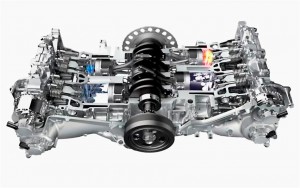
For a high-performance sports car driven full-tilt, this is exactly what you want.
But for a street car, just poking along, it’s not ideal.
Check the contrasting power curves:
The BRZ’s maximum output does not happen until 7,000 RPM – as opposed to 5,600 RPM for the Impreza WRX’s turbo’d 2.0 engine. And the BRZ’s torque maximum – just 151 ft. lbs. – requires 6,400 RPM.
As opposed to 258 ft.-lbs. at 2,000 RPM for the WRX.
Its engine (also a 2.0 liter four, but in-line) produces less power (155 hp) but delivers it 1,000 RPM lower than the BRZ’s engine does. And the Miata’s torque output (148 ft.-lbs.) happens almost 2,000 RPM sooner – at 4,600 RPM.
To express it colloquially, the Miata is much more wife-drivable than the BRZ.
Speaking of which: An automatic transmission is available … but re-read the torque numbers above.
Do not buy the optional six-speed automatic.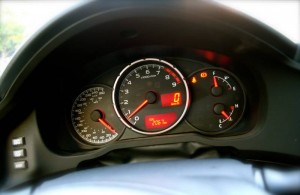
Automatics need torque to work decently and the BRZ’s four hasn’t got enough of it – and the little that’s available has to be reached for like a cookie jar on top of the ‘fridge, such that it takes the automatic-equipped BRZ a full second longer to achieve 60 MPH. The manual BRZ can do it in about 6.7 seconds, with a driver who knows how to work the engine. With the automatic, which doesn’t work well with this high-strung engine, you are looking at an 8 second run.
The automatic version does deliver economy car gas mileage: 25 city, 34 highway vs. 22 city, 30 highway for the six-speed manual version.
But this isn’t an economy car.
Note that premium fuel is required.
The more tractable Miata can be fed regular.
Did you ever see the Clint Eastwood movie, Heartbreak Ridge? It’s about an old Marine gunnery sergeant who does not fit well into civilian life – or even peacetime military life. His soft-handed battalion commander tells him he should be kept in stasis in a box, like a fire-extinguisher, with a sticker on it that reads: “Break glass in time of war.”
The BRZ is kind of like the gunny.
It loves to run, hates to walk. It is doable as a commuter car, but the Miata does that job better. If you don’t wind the boxer engine out in each gear, not much happens, acceleration-wise. The posted 0-60 time does not convey the everyday driving reality of the BRZ. Almost any other car with a similar number will feel pretty strong with the pedal pushed halfway down. In the BRZ, you must push the pedal all the way down – pretty much all the time.
The torque deficit is the car’s real weakness as a street car.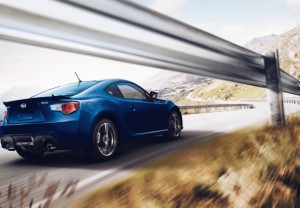
A weakness that is magnified by the car’s surprisingly high curb weight of 2,764 pounds (vs. 2,332 pounds for the Miata). Torque, a measure of twisting or rotational force, is what gets a car moving. Heavy cars don’t get moving very well without plenty of torque to turn the wheels. Combine not much torque with lots of weight and you have a problem. Especially if you saddle the thing with an automatic.
At least with the manual, you can wind the little four out and make use of what’s available.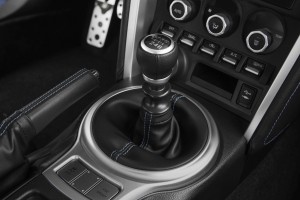
Which is all kinds of fun.
The shifter is a joy to play with, the clutch take-up just right. You sit, gunfighter-style, looking out over a sloping hood with the centerline defined by the power bulges on each periphery. A glance in the side mirror reveals the appealing curvature of the rear fender flares, 911-style.
And that’s what this car reminds me of most of all. A classic Porsche. The early 911s weren’t especially speedy – and the speed they had you had to work for. But it was mechanical marvelousness. A fusion of flesh and blood and steel and rubber. Those early 911s were for experten – people who knew their business.
Example: The emergency brake tension is not (as in almost every other new car) set so lightly that it’s not possible to use it to lock the rear wheels up while you’re moving. Here, you can. Why would you want to do that? An experten knows why. If you do not, this car isn’t for you.
Another: The VSC/Traction control is extremely liberal when turned off. You want to drift? By all means. But know what you are doing before you push the button for “off.”
One more: The BRZ’s standard wheel/tire package is much more aggressive than the Miata’s. Seventeens and low-aspect ratio/speed-rated performance tires vs. sixteens and all-seasons. Mazda does offer more serious equipment as part of the optional Club package. But it’s optional. The BRZ is serious – as it sits.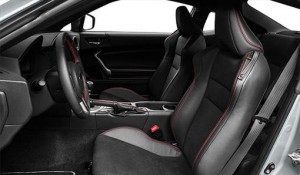
Last item: The BRZ’s Recaro-style sport buckets are track-ready seats. With side bolsters and only missing the five-point harness. They are actually comfortable, too.
And you can get them with heaters.
So it’s not that the BRZ isn’t civilized. It’s just more of an animal than the Miata.
AT THE CURB
It’s a coupe – as opposed to the Miata’s convertible. The hardtop provides structural rigidity – as well as physical protection if you roll the thing. Plus, convertible soft tops don’t age well. The fabric stains – and rips. Nature of the beast.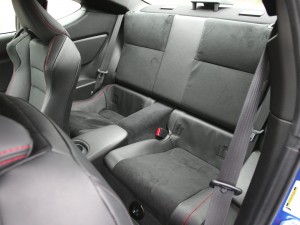
It’s also a two-plus-two (four seater) as opposed to the Mazda’s two seats. This, too, has its pros -and cons.
Obviously, you have the theoretical capability to carry more than just one passenger. And you have the actuality of some extra room for things. But, don’t be fooled. The BRZ is a two-person car with some additional space behind the front seats. The advertised rear seat legroom – 29.9 inches – assumes the front seats are pulled forward such that (taller people, at least) will be uncomfortable up there, too. And if you’re over six feet, as I am, driving the car (with the manual) will be awkward at best without the front seat slid back sufficiently to provide the necessary leg maneuvering room… which pretty much eliminates legroom for the theoretical back seaters.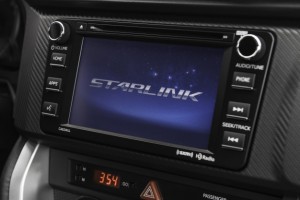
Still, it’s the more practical of the two in this respect. You get the additional storage and potential people room inside the cabin. And you get a larger trunk, too. The Soobie’s is 6.9 cubic feet vs. 4.9 for the Miata.
Of a piece, the secondary controls are large and hand-grabable, without needing to look at them. Toggles for the AC and knobs for the temperature and fan. The new LCD screen is much simpler than most, with four major menu items (Audio, Apps, Phone, Settings) and four large touch buttons to access them.
One not-practical thing about the BRZ is the center console’s cupholders – which are situated far rearward and so ideally positioned such that your right elbow is guaranteed to back into your coffee as you shift, spilling it all over. That leaves the openings in the lower door panels, which Subaru advises not be used to hold coffee cups because the slots are located such that you are likely to make a mess. Again. Basically, Subaru is telling you to drive the car – and if you want coffee, pit for 10 minutes at Starbucks.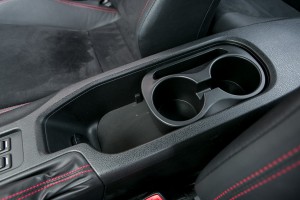
Oddly, there is no oil pressure gauge. A sports car should have that – even if Subaru believes the Boxer engine’s oiling system is failsafe.
This is, after all, a track-day car masquerading as a street car.
On the upside, the oil filter is… on the upside. Right there, on top of the engine.
You can remove it by hand, without tools.
Back in 2011, when Subaru and Toyota announced the joint development of a new high-performance sports car – what would become the BRZ and FR-S – everyone thought it would upset the proverbial apple cart.
Mazda’s apple cart, in particular.
It hasn’t happened.
The Miata – just redesigned – is more successful than ever.
Despite having 45 fewer horses under its hood (and two fewer seats) than the Subaru/Scion twins.
But the Miata’s also carrying about 400 pounds less curb weight than the twins. Despite the Mazda being a convertible (they usually weigh more).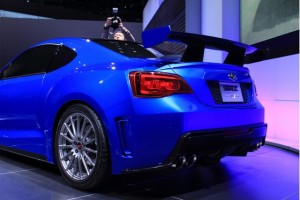
That is a problem.
The SoobieScion needs more horses – or less curb weight.
Either would help.
Both would be great.
Enter the STi.
Yes, it’s heavier. But its 305 hp makes up for that.
The turbo fixes the low-end grunt issue – and the AWD makes it handle even better. The problem is the price – almost $40,000 before the gouging begins. Given only 700 will be made, expect the gouging to be savage. (Have you checked what Skyline GT-Rs are going for?)
The STi’s price – and, frankly, its complexity – may be at odds with the car’s original mission. Which was to offer affordable, back-to-basics sports car performance. The BRZ is still that.
The BRZ STi, for all its charms, isn’t.
It will have to face down prestige-branded BMW Z4s, Porsche Caymans and others like that. Can it do so? We’ll soon see.
THE BOTTOM LINE
Consider it the un-Miata. A sports car you don’t buy for the trophy wife.
The one you buy for you.
EPautos.com depends on you to keep the wheels turning! The control freaks (Clovers) hate us. Goo-guhl blackballed us.
Will you help us?
Our donate button is here.
If you prefer not to use PayPal, our mailing address is:
EPautos
721 Hummingbird Lane SE
Copper Hill, VA 24079
PS: EPautos stickers are free to those who sign up for a $5 or more monthly recurring donation to support EPautos, or for a one-time donation of $10 or more. (Please be sure to tell us you want a sticker – and also, provide an address, so we know where to mail the thing!)


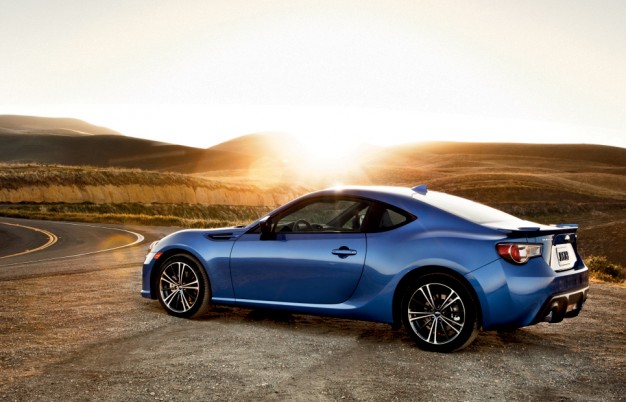

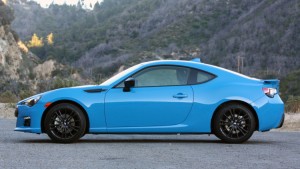
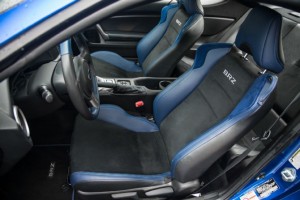
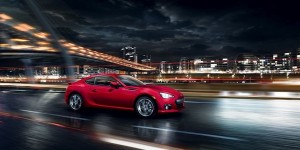

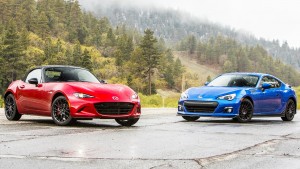
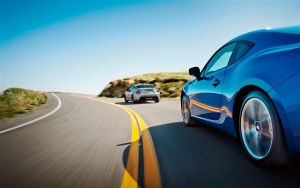


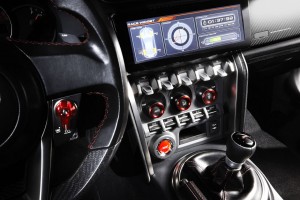







I’m 29,000 miles in on my ’13 FR-S. I enjoyed enjoyed driving it through a Pennsylvania Winter; then drove it to California where my driving, other than autocross, is solid Sacramento city commutes. I’m 66 years young and love my car more every day. No regrets at all and it has been absolutely reliable and nonstop fun. Kudos to Toyobaru.
Hi Lon,
I like this car a lot as well.
It comes down to whether one is a driver. Someone who likes to work a car – and appreciates a car that returns the interest!
Bear in mind that speed is relative. The BRZ/FRS are “underpowered” compared to many current sports cars. The BRZ/FRS are also just as fast 0-60 and 1/4 mile than many “muscle” cars from the 60s and 70s – and would certainly smoke those cars on a curvy road.
As to the relative lack of power/torque, I sold a dirt bike and used the money to resolve that issue for $2300 with an electric supercharger and e-tune.
The e-charger adds 40 peak hp, and dramatically improves the torque curve. The stock boxer engine has approx. 115 ft/lbs of torque at the rear wheels at 4000 rpm. The e-charger version has 180+ ft/lbs at 4000 rpm.
The peak HP at the rear wheels stock is around 165 hp. The peak HP with the e-charger is 205 hp.
Think an infinitely renewable and smoother/more controllable 50+ shot of nitrous. Comes on at 70-80% throttle. Recharges off the alternator at anything below 70% throttle. You get approximately 30 seconds of boost before the batteries are drained. I’ve never drained the batteries on the street. It recharges pretty quickly.
The car is transformed. You can light up the rear tires, should you choose to. 0-60 time drops from the mid 6s to the high 5s.
The same e-charger is being used with great success in the Miata.
Google Phantom Superchargers for more information.
Dynos here:
BRZ/FRS:
http://imgur.com/yE0aV33
Miata:
http://imgur.com/o6b98va
Seriously, guys. Have you complainers actually driven a BRZ?
As to reliability issues, please refer me to any serious, repetitive issues you’ve found. Most of the “reliability” complaints are about interior rattles and “crickets” noise from the direct injection. I’m 27k miles into a 2013 and yes, there are rattles and there is crickets noise from the direct injection. I fixed rattles (mostly coming from the door panel) by self installing some insulation and taping around the little box that holds the window switches.
The car has been mechanically and electronically flawless, save for the GPS system not connecting to the satellite, occasionally.
Yes, I drove the BRZ and the FR-S. I bought an F-type. The twins car was excellent. For $24,000 max. It’s one thing to get a $60,000 car for $72K, that accepts ECU tunes, already supercharged, OEM upgrades from higher trim levels, etc, etc… but a nearly un-tunable tuner car? Nah… Couldn’t do it, couldn’t hand $32,000 over for the ‘special edition’ just because I wanted yellow.
Supposedly, they couldn’t do an AWD version of this because the engine sits too low so as to block any sort of transaxle access to the front wheels. It would require jacking the engine upwards several inches, which would hurt the styling and balance.
Oddly, it turns out this is not a terribly reliable car, especially considering it is a Toyota/Subaru, both of which are normally known for reliability. I suspect part of this may be the collaboration, but Toyota has collaborated with others, particularly General Motors, in the past and still churned out solid machines. The bigger factor may be that this is the sort of car that is built to hoon. They are likely not treated kindly, and its low power, high revving engine only feeds into this tendency.
I’d have to say, though. I’d rather have a Miata.
Thanks for the review! I really want to want this car. But I’m from Jersey. Only windy roads I see are parkway off ramp. Plus I drive clover speeds on the highway. I doubt I’d spend the cash to ride it on a track. I sadly think I will enjoy blasting off on stoplights with a mustang more.
But like I said, I really want to want the BRZ. I am in the market for a new vehicle. Eric’s review is reinforcing my hesitation. Redlining all the time does sound interesting.
My pleasure, C_lover!
This is just my opinion, but: A car like the Mustang is more everyday enjoyable because you can use the power it has to out-accelerate the Cloverized herd. The BRZ can only do that if you work it. For everyday driving, I have to say I’d pick a Miata. It’s got more range – even if it has less room!
“A boxer engine is a good design and has been used in everything including ag equipment…..”
My point exactly.
Porsche does ok with them! 🙂
Porsche spends a lot more time and money on Boxer R&D. Right, Subaru prices can’t accommodate that much investment. So maybe they shouldn’t have been so ambitious?
I’m not condemning every version of this engine configuration.
But if they wanted to create the next great affordable sports car, Subaru (and Toyota) really blew it.
Looks like the current Boxer engine is not sophisticated enough for this assignment. It either woefully lacks adequate torque, or with turbo, will become a strong, but coarse, blunt, source of power.
That low center of gravity is nice, but…..
I keep waiting and hoping for “the next” 240 Z, or CRX-Si.
The BRZ comes so close to being an icon. That only makes it’s failure more disappointing.
I have to agree with Rich. The boxer is too small for the weight. It could be tuned for more torque at a lower rpm but then it wouldn’t be the revver it is. It’s a lot of fun to keep one wound out all the time and that’s the way it would be for me and most likely will be for others. I see it gaining half a liter for the next year and mpg be damned. A boxer engine is a good design and has been used in everything including ag equipment(Poppin Johnny for an instance).
You’ll be waiting till the cows come home for another 240 Z since it’s forte was a light body and an engine with torque much lower in the band. It also had a compression ratio high enough with no sophisticated valve train or timing yoohoos to take advantage of good old inline torque and the ability to rev freely.
I’d buy a new 240 Z in a heartbeat.
They would likely be selling far more of them had they been able to shed 500 lbs off of it, and $7000 off the sticker. At the price it’s at, you can get a pretty nice entry level Mustang, I bet some people who look at BRZ’s end up buying Mustangs.
I wouldn’t compare this car to a Mustang of any configuration. It is what it is and that’s a high-revver, balls to the wall handling machine. I love this sort of car but hate it’s short life in my hands.
For a guy who likes to drift a belly dump hooked to a short wheel base KW with a Cat engine, you can imagine what I’d do with this. The AWD version would be great on those roads with traction that varies from nearly nothing to nearly too much.
It would be a great early Sunday morning car.